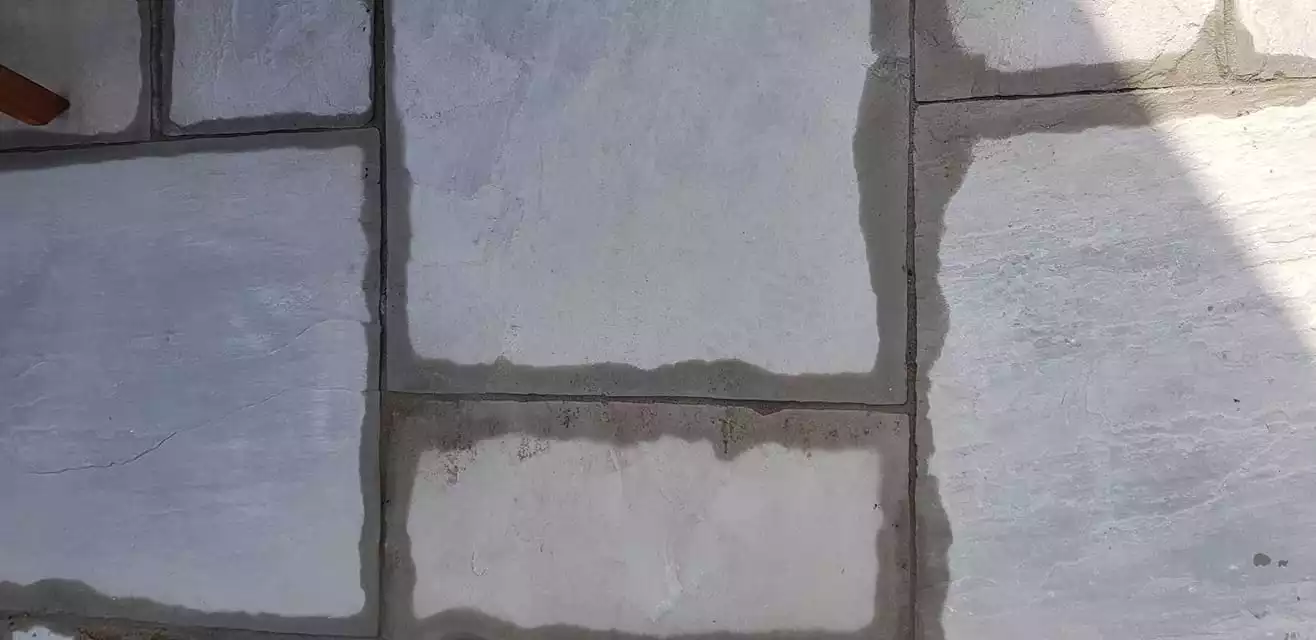How to Make Mortar for Pointing Patio?
4:1 is the most preferred sand to cement ratio for making the patio pointing mortar. 3:1 or 5:1 is also fine and there isn’t a noticeable difference but 4:1 is more balanced in terms of strength.
Add one part cement to four parts soft or building sand and mix it before adding water till the cement disappears. Then start adding water in small quantities while mixing it in between. To know when the mix has the right quantity of water is when it is not too wet and not too dry.
There are a lot of other different options available in the market today to point patios and fill in the gaps between the slabs which are much quicker to use compared to traditional sand and cement mortar.
For example, brush-in jointing compounds like Easyjoint and Joint-It. These are ready-mixed jointing compounds that just need to be swept with enough water into the joints. Most professionals are now using jointing compounds as it saves them a lot of time and helps to close the job much quicker which also means faster payment.
However, no matter how easy or fast these jointing compounds are, some people still prefer the traditional way of pointing that’s a trowel and sand and cement mortar.
Both methods have their own pros and cons. Jointing compounds are easy and fast but quite expensive like £40-£50 for a tub that generally covers the joints in a 10-15 m2 area of the patio depending on the product you choose because different brands have different quantities per tub or per bag. To know more about these jointing compound coverage, check out this post on the site.
If you’ll be using a mortar gun or pointing a gun to point the patio, the mixture is everything like getting the mortar mix correct is very necessary in order for the gun to function properly. There’s a post on the site on how to get the ideal mortar mix for pointing guns if you’re going that route.
Making mortar to point a patio using a trowel shouldn’t be as hard as making mortar to point a patio using a mortar gun. To make mortar for the mortar guns, you really need the hang of it. Every quantity of the sand, cement and water matters in that case and will take a couple of tries to make a smooth mixture. But it doesn’t matter when pointing with a trowel. How smooth the mixture is just isn’t a problem here because eventually, you’re going to use a trowel and not a mortar gun for pointing.
However, it doesn’t mean that you’re allowed to totally messed up with the mortar. Incorrect mortar can lead the pointing to start cracking very soon and won’t last long. Read this post newly done patio pointing cracked to know other reasons behind it.
Tools & Ingredients
Bucket & Trowel
Use a bucket and trowel to mix the mortar if you want to make it in small quantities. And, it’s recommended to mix the mortar in small quantities so you are able to point it before it dries out.
If you have a 15-litre bucket, you can mix enough mortar in it at a time which will cover 10-15m2 of the patio to point. So if you have 50m2 to point, you’ll need to make the mortar 3-5 times, one bucket at a time, depending on the depth and width of joints.
Building or Soft Sand
First, let’s see why sand is required in mortar? Only cement with water will crack when it dries out hence sand is used. Now, there’s a lot of confusion on which sand to use for pointing patios. Soft sand, also known as building sand is mostly preferred and used to make the mortar for pointing.
Can sharp sand or kiln dried sand be used for pointing a patio?
Strictly no with mortar guns but sharp sand should also be avoided in the mortar when pointing with a trowel if you want a smooth and better finish. You can use with certain proportion with soft sand (3 soft and 1 sharp) but it will give a little bit of texture and uneven finish to the pointing.
Honestly, it’s a personal choice some prefer soft sand, some sharp while some use both in certain quantities.
Kiln dried sand is the sand that’s used to fill in the joints of block paving but can you use it to make mortar for pointing a patio? Kiln dried sand isn’t the best type of sand to use in mortar for pointing patios and you should stick with building sand for this purpose.
I came across a post on Facebook where the person used kiln dried sand for pointing and the result he got was as follows.

Cement
Cement is required in less quantity compared to sand to make pointing mortar. As said earlier, mix the cement well with the sand before and then go on adding the water to it.
Water
Don’t go on adding the water directly with the hose especially if you’re mixing the mortar in small quantities. Take the water out in a bucket or something like that then add it with something smaller when necessary.
As I already said, at a point the mortar will be not too dry and even not too wet. It is when you’ve to stop adding any more water to it. Sometimes, the excess water in the mortar could cause staining on the slabs if they soak it especially the porous slabs like Indian sandstone.
It doesn’t mean the mortar should lack water. Some people keep it very dry because of the risk of staining the slabs and it has other downsides. Let’s talk about it later in the post.
Dry Mix for Pointing
Some people keep the mortar quite dry by using a little less water in it to avoid staining and they’re correct in a way because if you end up staining the slabs while pointing, you’ll have a hard time cleaning them.
But making it too dry will make it difficult to go everywhere into the joints compared to a little bit wetter mix which may lack in strength. Just follow the rule of not too dry and not too wet while making the mortar and you’ll get a balanced mix that will less likely to stain the slabs and also get all over into the joints really well.
Once you finish making mortar, there’re a lot of good videos on YouTube on how to point a patio that also shows necessary steps like cleaning the joints before pointing. Watch them to know what to do further with the mortar.
